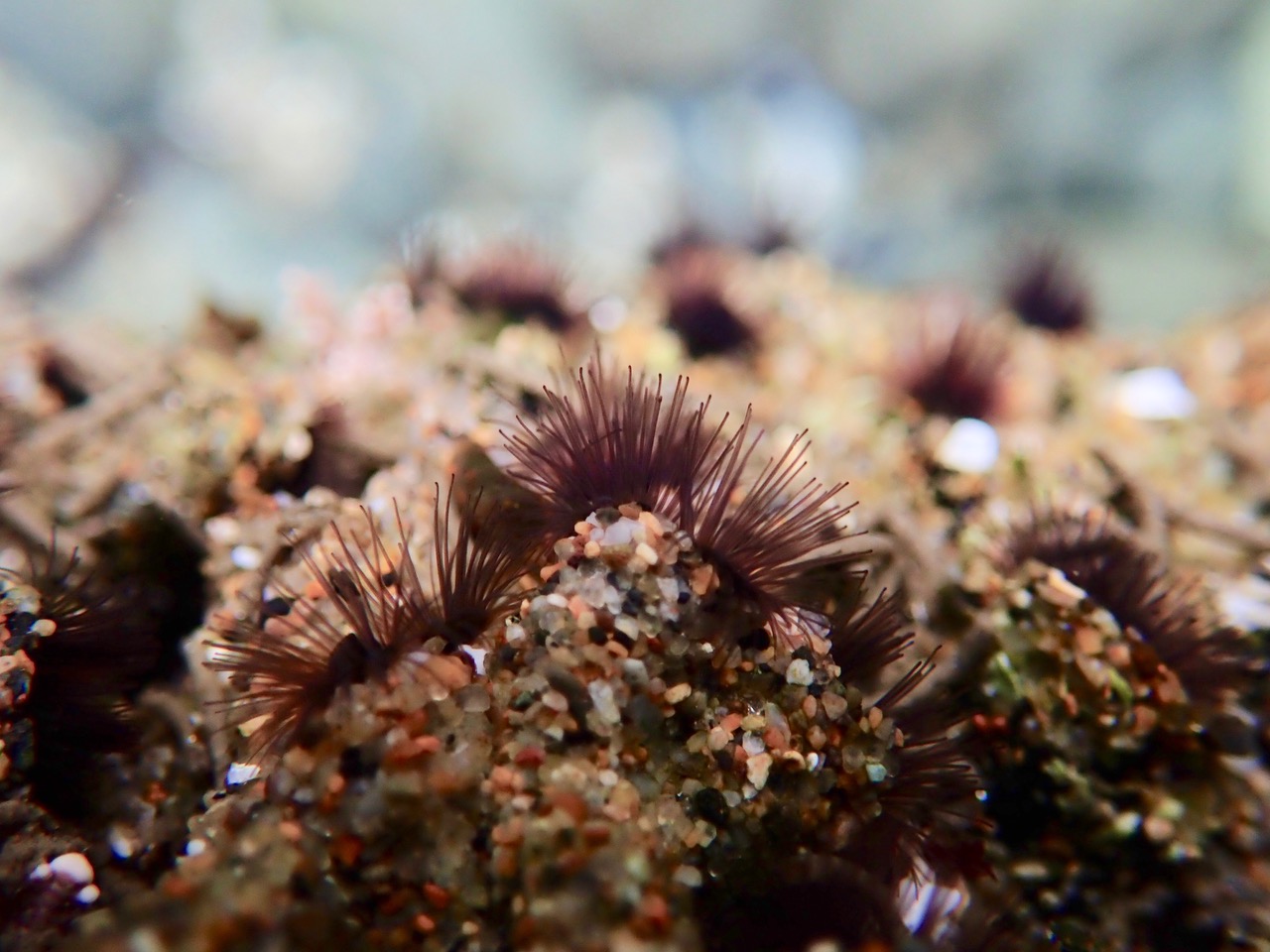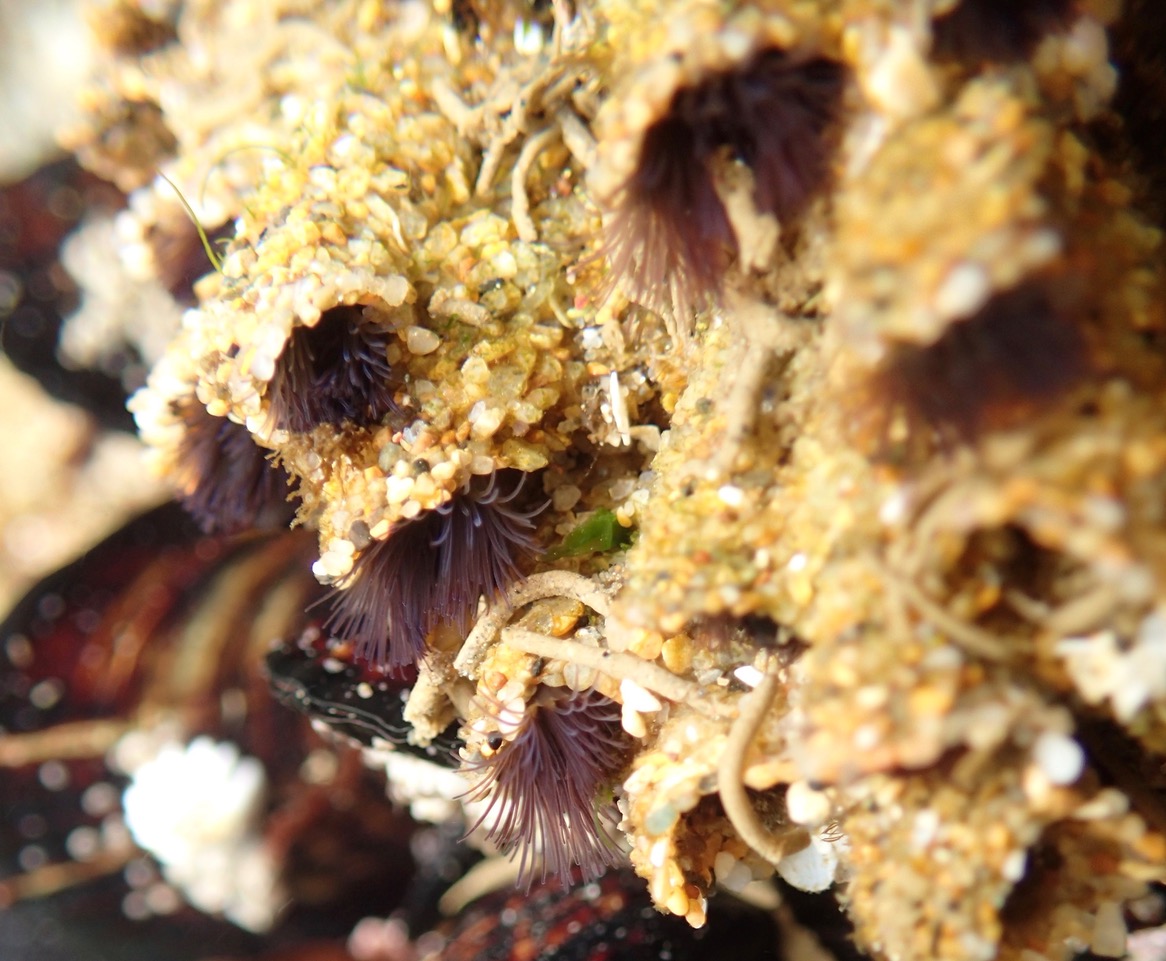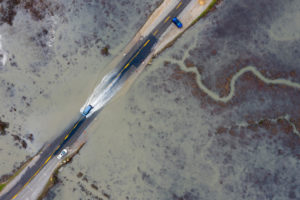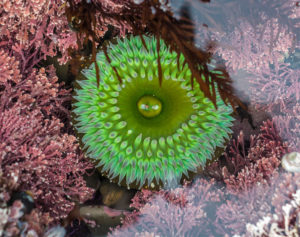If, like me, you are fortunate enough to live near the coast in Northern California, you get to visit the tidepools. And when you do, you may notice something that looks like a pile of sand in the mid-tidal zone below the mussel beds. When you venture down and touch the sand, you’ll find that it’s hard — hard enough to walk on, if you step very carefully, but also somewhat brittle.
It might look something like this:

Meet Phragmatopoma californica, the sandcastle worm. Hard to believe that these mounds, which can be the size of a small dining room table, are constructed by little worms, isn’t it? Phragmatopoma is one of the many marine segmented worms grouped together as the Polychaeta. We have lots of polychaetes on our coast, ranging in size from greater-than-hand-length nereids and glycerids that can take a bite out of you and draw blood, to tiny worms small enough to swim in the layer of water between sand grains. In fact, the majority of our worm fauna on the coast consists of polychaetes.
Polychaetes make up a large and very diverse taxon, comprising some 80 or so families. Polychaete taxonomists might argue against it, but to make things simpler, we can divide them into two subclasses, the Errantia and the Sedentaria. As the name implies, the Errantia comprises the worms that are errant, or free-crawling. That said, most of them don’t actually crawl around in plain sight; they tend to burrow in sediment, shell debris, or gravel, or wiggle their way through various benthic faunal communities. Some of them make temporary shelters by wrapping themselves in pieces of algae sewn shut with mucus threads. The Sedentaria, on the other hand, are pretty much all, well, sedentary. They live in more or less permanent tubes made of various materials, and generally can’t live outside of them.
Phragmatopoma is very much a sedentary worm. It lives in a tube that it builds out of sand grains. Yes, this little worm is a mason!

What you see in these mounds is an aggregation of hundreds of individual worms. The mounds do not form by accident or chance. Phragmatopoma has a planktonic larval stage that floats around on ocean currents for some weeks before returning to the shore. The larva is attracted to areas already colonized by members of their species, which it detects by sniffing out the chemical signal of the glue used to create the tubes (more on that below). This phenomenon is called gregarious settlement. If you consider the challenge of being a tiny creature searching the entire coastline for a place to settle and live forever, one big clue as to the suitability of a given location is the presence of adults of the same species. After all, if your parents’ generation grew up there, chances are it’s a good spot for you to grow up, too.
Each of those holes in the big sandy mound is the entrance to a worm’s tube. Tubes might be as long as 15 centimeters, but the worm itself is much smaller: a whopping big one would be 4 centimeters long, and most are in the 2-3 centimeter size range. From this pair of observations I infer that the worms can and do move up and down the tube. They have to move to the open end of the tube to feed, and can withdraw towards the closed end to avoid predators, or seek protection from drying out.

Phragmatopoma‘s tube is not a haphazardly constructed object. It is the worm’s home for the entirety of its post-larval life, and is constructed to shield its builder/occupant from the mechanical bashing that occurs twice daily as the tide floods and ebbs. As such, it must be strong and able to maintain its structural integrity. Let’s take a closer look at an isolated tube under the dissecting scope:

The tube itself is made of debris–sand grains, bits of shell, the occasional tiny sea urchin spine–that the worm gathers from its environment. Glandular regions at the worm’s anterior region secrete a cylinder of sticky cement around its body that is chemically similar to both spider silk and the byssal threads that mussels use to attach themselves to rocks in the intertidal. The inside of the tube is lined with a chitin-like material. The worm uses tentacles on its head region to collect and sort the “stones” and glue them to the outside of the lining. There is some degree of selection involved; in the photo above you can see that all of the sand grains are more or less the same size, with none standing out as being conspicuously smaller or larger than the others. Growing worms that are actively building their tubes may be geographically restricted at least partly by the availability sand grains of the right size; if the sand is too fine or too coarse, the worms either can’t or don’t live there.
Life inside a tube
Living in a tube may provide significant protection from wave bashing and predators, but it does present some challenges as well. One thing that comes to mind is the matter of personal hygiene: What happens to the worm’s poop? As we know, the worm lives inside the tube but is not attached to it, and can crawl up and down within it. To understand how it does, we have to review some basics of polychaete anatomy.
The word “polychaete” comes from Greek (“many bristles”) and refers to the fact that these segmented worms have chaetae, or bristles, along the left and right sides of the body. In some worms the segments, including chaetae, are pretty much the same from the front of the body to the back. In others, the segments and chaetae are differentiated from one body region to another. In the case of Phragmatopoma, all you can see sticking out of a tube is the head region, consisting of the slender feeding tentacles and a large disc-shaped structure called an operculum, which made of fused cephalic chaetae and serves as a door to close off the tube when the worm withdraws. Behind the head is a collar region, a series of three adjacent segments that have very stiff chaetae that can be pushed out against the lining of the tube to anchor the body in place. The rest of the body behind the collar is the trunk, which bears smaller chaetae on each segment. The entire epidermis is ciliated, which keeps water flowing around the body.
But what about the poop? As in most vermiform animals, Phragmatopoma‘s anus is at the posterior end of the body, which is oriented towards the closed end of the tube. How, then, does it defecate without fouling its home? The answer is both simple and ingenious. Phragmatopoma has a long rectum, which is curved to run anteriorly back towards the head. The anus, located at the terminal end of the rectum, discharges fecal pellets about halfway up the length of the body. The ciliary currents of the epidermis then flush the fecal pellets the rest of the way up the tube and out the top.
The skinny cylindrical things in the photo below are Phragmatopoma‘s fecal pellets!

Gas exchange is another challenge for animals that live within tubes. Aquatic animals exchange respiratory gases with the water that surrounds them, which is easy for animals that live where the water is constantly moving over their bodies. But for tube-dwellers, gas exchange is much more difficult. Phragmatopoma has paired gills on each segment of the trunk region of the body, which greatly increase the surface area for gas exchange. Any gas exchange surface is useless unless it connects with the circulatory system, so blood vessels flow into and out of each gill. Dissolved oxygen diffuses from the water into the blood, and is then circulated throughout the body. A certain amount of gas exchange probably occurs across the surface of the tentacles, too. To make things easier, the ciliated epidermis of the body keeps that small amount of water inside the tube moving, minimizing stagnation. When the worm’s head is extended out for feeding, the tube is flushed with clean water. When the worm is withdrawn into the tube at low tide, its only oxygen supply is in the water contained in the tube with it. Like most of its intertidal neighbors, Phragmatopoma hunkers down and waits for the tide to return, when it can feed and breathe more easily.
And speaking of feeding, I should mention that Phragmatopoma is a filter feeder. Those purple tentacles are ciliated and create a water current that brings small suspended particles towards the mouth located at the base of the tentacles. In the video below the operculum is the darker object to the left; it represents the dorsal side of the worm’s body. The long, filiform tentacles are the feeding tentacles.
As you may imagine, living in a tube also affects the way that Phragmatopoma reproduces. The worms never leave their tubes, so copulation isn’t an option for them. Despite their occurrence in large groups they are not clonal, and reproduce only sexually. Both sexes of Phragmatopoma spawn gametes into the water, where fertilization and larval development take place. Living in dense aggregations and spawning at the same time as everyone else maximizes the chance that egg and sperm of the same species will find each other. Many marine invertebrates throughout the oceans, from corals to sea urchins, spawn synchronously. After all, it does an individual no good to throw gametes out into the world if it is the only one of its type around–all of the metabolic energy that went into producing and maintaining the gametes would be entirely wasted.
Clearly, the advantages of living in a tube outweigh the costs and inconveniences. Phragmatopoma has evolved physiological, anatomical, and behavioral adaptations to deal with life in the intertidal. One of those adaptations is the tube, which solves one set of problems but creates others which also need to be solved if the animal is to survive. Evolution comes up with solutions like this all the time. Every trait has metabolic and/or fitness costs, and an organism’s biology is based on this type of evolutionary compromise. Life in the intertidal is a tough game. It is probable that none of the various biological processes that keep Phragmatopoma alive work function quite as well as they could if they were isolated systems. But inside the bodies of these little worms, everything works just well enough for them to be one of the more conspicuous inhabitants of the intertidal.




